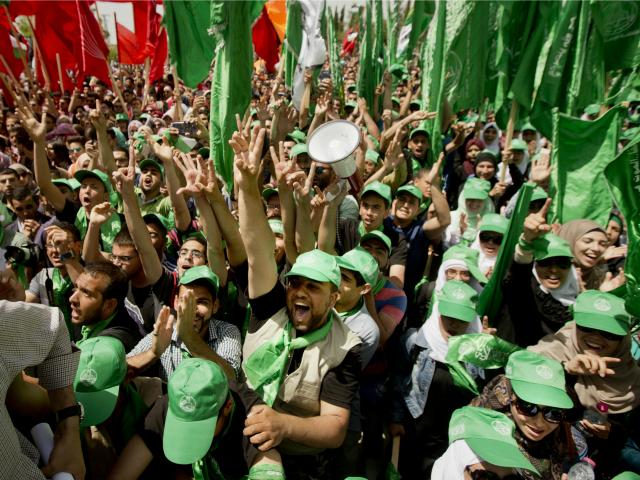While the news media is largely describing “protesters” seeking to end the blockade of the Gaza Strip and create a Palestinian state, many so-called demonstrators approaching the Israeli border have been reportedly armed with weapons and attempting to attack Israeli soldiers.
Hamas itself provided evidence that it is cynically utilizing the cover of civilian demonstrators to attack Israel, thus drawing Israeli fire toward the crowds. On Saturday, Hamas released photographs of five members of its so-called military wing, the Izz ad-Din al-Qassam Brigades jihad unit, announcing they were among the 16 Gazans reportedly killed on Friday.
Hamas stated that the five jihadists were killed while taking part “in popular events side-by-side with their people.” In other words, the terrorists were killed most likely attempting to carry out attacks while surrounded by civilian protesters.
According to the IDF, rioters on Friday threw firebombs and hurled rocks at soldiers, attempted to breach the Israeli border, attempted to damage the border fence, and opened fire on Israeli troops.
The IDF released scores of pictures capturing the violence, including Palestinians in the midst of attacking soldiers. The images demonstrate Israel’s need to use force to quell riots in which some Gazans are attempting to violently storm the border of a sovereign nation or attack soldiers.
The Hamas terrorist organization organized the mass riots under the banner of the “March of Return”, seeking to escalate protests the next few weeks leading up to Israel’s 70th Anniversary celebrations next month and the relocation of the U.S. embassy from Tel Aviv to Jerusalem in May.
On Friday, this reporter analyzed some of the reasons Hamas may have organized the mass protests:
The Islamist terrorist group understands the Gaza population is frustrated that 11 years of Hamas rule has resulted in destructive wars – launched each time by Hamas itself – and an economy dangerously teetering on the brink of collapse. Hamas’s decision to turn Gaza into a terrorist enclave has prompted an Israel-Egypt boycott that has impacted all aspects of Gaza life, although Israel allows for truckloads of humanitarian goods and supplies per day to enter Gaza.
Gazan’s are also suffering from the Hamas-Fatah divide, with the rulers of the West Bank and Gaza Strip failing to reach a reconciliation agreement that would likely result in the flow of aid to Gaza.
Hamas views Israel’s upcoming 70th anniversary and President Donald Trump’s historic decision to relocate the U.S. embassy to Jerusalem as perfect opportunities to channel Gazans anger and redirect the rage toward the easiest target – Israel.
Hamas knows the ensuing casualty count will bring international news media attention to the humanitarian crisis in Gaza, and it will thrust the issue to the forefront of the foreign policy debate.
The border clashes may also press Egypt into easing the blockade and putting Egyptian pressure on Palestinian Authority President Mahmoud Abbas’s Fatah party to reach a reconciliation deal since Gaza tensions usually favor the jihadists operating against Egypt in the Sinai. Abbas must fear that the protests could spread to the West Bank and threaten his rule there.
Lastly, Hamas may also be signaling to Iran and to other potential state patrons that Hamas is still the dominant player in Gaza and that it is useful to financially support the terrorist movement once again.
In failing to provide the full context for the deadly border riots, the news media are unwittingly helping Hamas achieve its objectives.
Aaron Klein is Breitbart’s Jerusalem bureau chief and senior investigative reporter. He is a New York Times bestselling author and hosts the popular weekend talk radio program, “Aaron Klein Investigative Radio.” Follow him on Twitter @AaronKleinShow. Follow him on Facebook.

COMMENTS
Please let us know if you're having issues with commenting.